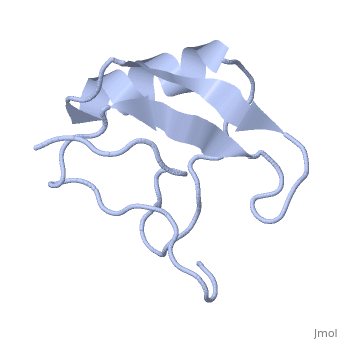1lqh
From Proteopedia
INSECTICIDAL ALPHA SCORPION TOXIN ISOLATED FROM THE VENOM OF SCORPION LEIURUS QUINQUESTRIATUS HEBRAEUS, NMR, MINIMIZED AVERAGE STRUCTURE
Structural highlights
FunctionSCXA_LEIHE Alpha toxins bind voltage-independently at site-3 of sodium channels (Nav) and inhibit the inactivation of the activated channels, thereby blocking neuronal transmission. The dissociation is voltage-dependent. This toxin is active on insects. It is also highly toxic to crustaceans and has a measurable but low toxicity to mice. Evolutionary ConservationCheck, as determined by ConSurfDB. You may read the explanation of the method and the full data available from ConSurf. Publication Abstract from PubMedThe solution structure of a recombinant active alpha-neurotoxin from Leiurus quinquestriatus hebraeus, Lqh(alpha)IT, was determined by proton two-dimensional nuclear magnetic resonance spectroscopy (2D NMR). This toxin is the most insecticidal among scorpion alpha-neurotoxins and, therefore, serves as a model for clarifying the structural basis for their biological activity and selective toxicity. A set of 29 structures was generated without constraint violations exceeding 0.4 A. These structures had root mean square deviations of 0.49 and 1.00 A with respect to the average structure for backbone atoms and all heavy atoms, respectively. Similarly to other scorpion toxins, the structure of Lqh(alpha)IT consists of an alpha-helix, a three-strand antiparallel beta-sheet, three type I tight turns, a five-residue turn, and a hydrophobic patch that includes tyrosine and tryptophan rings in a "herringbone" arrangement. Positive phi angles were found for Ala50 and Asn11, suggesting their proximity to functionally important regions of the molecule. The sample exhibited conformational heterogeneity over a wide range of experimental conditions, and two conformations were observed for the majority of protein residues. The ratio between these conformations was temperature-dependent, and the rate of their interconversions was estimated to be on the order of 1-5 s(-1) at 308 K. The conformation of the polypeptide backbone of Lqh(alpha)IT is very similar to that of the most active antimammalian scorpion alpha-toxin, AaHII, from Androctonus australis Hector (60% amino acid sequence homology). Yet, several important differences were observed at the 5-residue turn comprising residues Lys8-Cys12, the C-terminal segment, and the mutual disposition of these two regions. 2D NMR studies of the R64H mutant, which is 3 times more toxic than the unmodified Lqh(alpha)IT, demonstrated the importance of the spatial orientation of the last residue side chain for toxicity of Lqh(alpha)IT. Solution structures of a highly insecticidal recombinant scorpion alpha-toxin and a mutant with increased activity.,Tugarinov V, Kustanovich I, Zilberberg N, Gurevitz M, Anglister J Biochemistry. 1997 Mar 4;36(9):2414-24. PMID:9054546[1] From MEDLINE®/PubMed®, a database of the U.S. National Library of Medicine. See AlsoReferences
| ||||||||||||||||||


